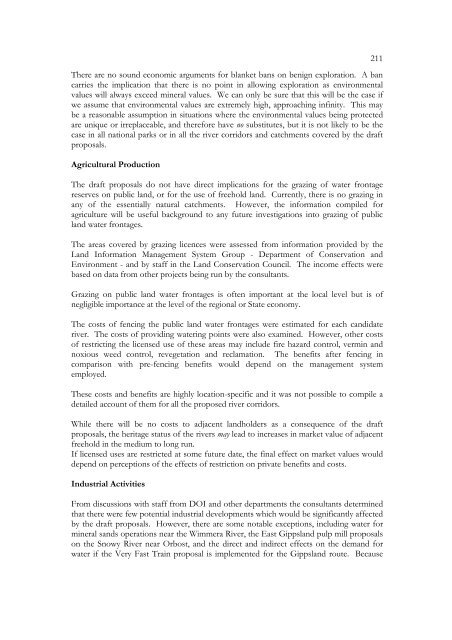APPENDIX I List Of Submissions - Victorian Environmental ...
APPENDIX I List Of Submissions - Victorian Environmental ...
APPENDIX I List Of Submissions - Victorian Environmental ...
You also want an ePaper? Increase the reach of your titles
YUMPU automatically turns print PDFs into web optimized ePapers that Google loves.
There are no sound economic arguments for blanket bans on benign exploration. A ban<br />
carries the implication that there is no point in allowing exploration as environmental<br />
values will always exceed mineral values. We can only be sure that this will be the case if<br />
we assume that environmental values are extremely high, approaching infinity. This may<br />
be a reasonable assumption in situations where the environmental values being protected<br />
are unique or irreplaceable, and therefore have no substitutes, but it is not likely to be the<br />
case in all national parks or in all the river corridors and catchments covered by the draft<br />
proposals.<br />
Agricultural Production<br />
The draft proposals do not have direct implications for the grazing of water frontage<br />
reserves on public land, or for the use of freehold land. Currently, there is no grazing in<br />
any of the essentially natural catchments. However, the information compiled for<br />
agriculture will be useful background to any future investigations into grazing of public<br />
land water frontages.<br />
The areas covered by grazing licences were assessed from information provided by the<br />
Land Information Management System Group - Department of Conservation and<br />
Environment - and by staff in the Land Conservation Council. The income effects were<br />
based on data from other projects being run by the consultants.<br />
Grazing on public land water frontages is often important at the local level but is of<br />
negligible importance at the level of the regional or State economy.<br />
The costs of fencing the public land water frontages were estimated for each candidate<br />
river. The costs of providing watering points were also examined. However, other costs<br />
of restricting the licensed use of these areas may include fire hazard control, vermin and<br />
noxious weed control, revegetation and reclamation. The benefits after fencing in<br />
comparison with pre-fencing benefits would depend on the management system<br />
employed.<br />
These costs and benefits are highly location-specific and it was not possible to compile a<br />
detailed account of them for all the proposed river corridors.<br />
While there will be no costs to adjacent landholders as a consequence of the draft<br />
proposals, the heritage status of the rivers may lead to increases in market value of adjacent<br />
freehold in the medium to long run.<br />
If licensed uses are restricted at some future date, the final effect on market values would<br />
depend on perceptions of the effects of restriction on private benefits and costs.<br />
Industrial Activities<br />
From discussions with staff from DOI and other departments the consultants determined<br />
that there were few potential industrial developments which would be significantly affected<br />
by the draft proposals. However, there are some notable exceptions, including water for<br />
mineral sands operations near the Wimmera River, the East Gippsland pulp mill proposals<br />
on the Snowy River near Orbost, and the direct and indirect effects on the demand for<br />
water if the Very Fast Train proposal is implemented for the Gippsland route. Because<br />
211
















